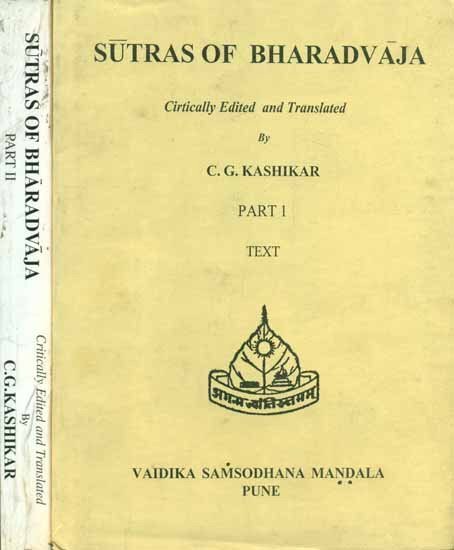Bharadvaja-srauta-sutra
by C. G. Kashikar | 1964 | 166,530 words
The English translation of the Bharadvaja-Srauta-Sutra, representing some of the oldest texts on Hindu rituals and rites of passages, dating to at least the 1st millennium BCE. The term Srautasutra refers to a class of Sanskrit Sutra literature dealing with ceremonies based on the Brahmana divisions of the Veda (Sruti). They include Vedic rituals r...
Praśna 14, Kaṇḍikā 3
1. Then he should make it hot over the Āgnīdhra fire with the formula, “Let speech and mind mix thee; let Prāṇa and Apāna mix thee; let eye and ear mix thee; let power and might mix thee; let vigour and endurance mix thee; let long life and old age mix thee; let the soul and the body mix thee; thou art become hot, made to be hot; for the hot thee; for the hot ones thee.”[1]
2. Then he should say, “O Hotṛ, do you utter what you have to utter.”[2]
3. When he knows the Hotṛ reciting the verse, “If the oblation is cooked, make the offering. If it is not cooked, wait,”[3] be should say, “The oblation is cooked.”
4. After having crossed and after having caused the Āgnīdhra to announce (and after the latter has responded,) be should say (to the Hotṛ), “Do you recite the yājyā relating to the offering of dadhi-gharma.”
5. At the vaṣaṭ-utterance be should make the offering with the verse, “Him whom they call Indra, him whom they call Varuṇa, him whom they call Mitra, him whom they call Satya, who is the greatest god among gods, born of penance, for him thee, for them thee, svāhā.”[4]
6. At the secondary vaṣaṭ-utterance he should make a second offering and retain some portion.
7. The officiating priests, who have partaken of the Pravargya, should consume it. The mantra for consuming it is the Anuvāka in the Taittirīya Āraṇyaka.[5]
8. There is another view that in a sacrifice without Pravargya there should be no offering of dadhigharma.
9. Then: the Adhvaryu should place the Savanīyapuroḍāśa.
10. After having gone through the rite of the Paśupuroḍāśa, he should offer the Savanīyapuroḍāśa.[6]
11. This much should be different: he should give out the calls (to the Maitrāvaruṇa): “Do you recite the puronuvākyā relating to the offering of the Savanīyapuroḍāśa to Indra at the midday pressing;” “Do you address a call to the Hotṛ to recite the yājyā relating to the offering of the Savanīyapuroḍāśa intended for Indra at the midday pressing.”
12. The Sviṣṭakṛt-offering, together with the call, of all Savanīyapuroḍāśas together with the Paśupuroḍāśa should be common; the Iḍā should also be common.
13. There is a view that there should be no Paśupuroḍāśa relating to the Savanīya animal.
14. One should pour down (the Soma-juice from) the Ādhavanīya into the Pūtabhṛt.
15. The procedure up to the calling out should be similar.[7]
16. This much should be different: the beginning of the call should be, “(O Maitrāvaruṇa, do you address a call to the Hotṛ to recite the yājyā) relating to the Soma-offerings to Indra of the midday pressing of the portion exclusively belonging to Indra consisting of Śukra and Manthin, and dropping sweetness.”
17. The procedure up to (the offering of) the cups to which Soma has been added from the Droṇakalaśa should be similar.[8]
18. The Acchāvāka should recite his yājyā before the Āgnīdhra.
19. The Adhvaryu should not place a piece of cake for the Acchāvāka[9] at this. time.
20. The Camasins should consume their respective goblets.
21. The formula for consuming Soma (from all cups) except the Nārāśaṃsa goblets in the midday pressing should be the very same, namely, “O god Soma, I, acquiesced, consume thee who hast the Rudras for thy troop, who knowest the mind, who belongest to the midday pressing, who hast the Triṣṭubh for thy metre, who art drunk, who hast sweetness and who art acquiesced.”.[10]
22. After having consumed the goblets incompletely, they should make them swell.
23. Making the goblets swell and the placing of them have already bean. explained.[11]
Footnotes and references:
[2]:
ĀśvŚS V.13.4.
[4]:
Taittirīya-brāhmaṇa III.7.9.
[5]:
XI.18.3; cf. also Taittirīya-brāhmaṇa III.7.9.4.
[6]:
XIII.21.15.
[7]:
XIII.25.5.
[8]:
XIII.26.1,2.
[9]:
XIII.27.16.
[11]:
XIII.27.23.25.
